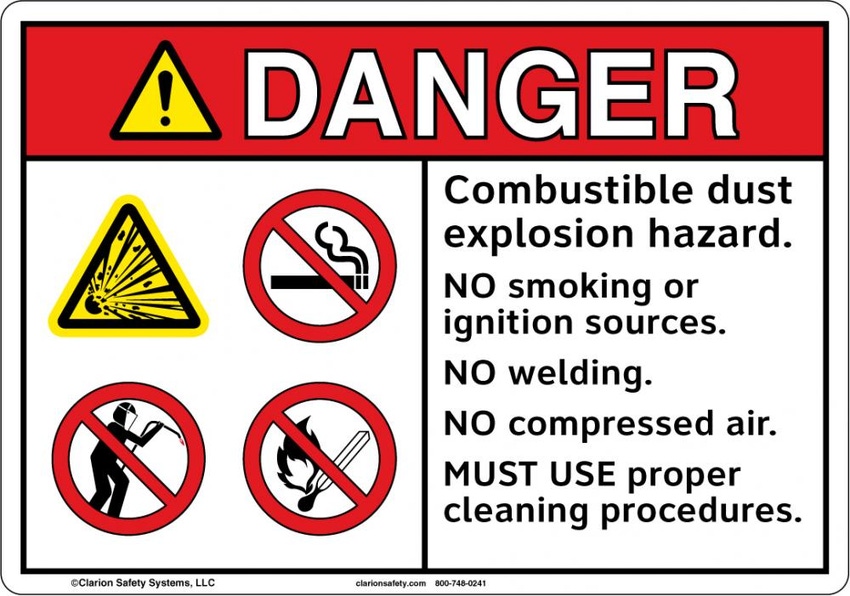Reducing the Risk of Combustible Dust Accidents: Effective Communication
August 14, 2012

Combustible dust poses a serious, often unrecognized, danger in a large number of industries. In the processing and packaging industries, combustible dust is a serious hazard faced on a daily basis. How can the hazard be reduced? Understanding the causes behind combustible dust explosions, implementing proper cleaning and maintenance procedures, and posting proper warnings and avoidance procedures are critical steps that can be taken to prevent disasters and save lives.
Understanding Combustible Dust Hazards
We all know that three factors are needed for a regular fire to occur: fuel, oxygen, and an ignition source. In a combustible dust explosion, two additional elements must be present: dispersion of dust particles in the air and confinement of the dust cloud. This grouping of five conditions is often referred to as the “explosion pentagon”. In a combustible dust explosion, the ‘fuel’ is the dust or fine particles. If a dust cloud is ignited within a confined space, it burns quickly and a powerful explosion can occur. But, the damage is not done at this point, alone. This initial or primary explosion may then dislodge accumulated dust and particles that have built up over time, serving as the fuel for secondary explosions which can be far more powerful and destructive because of the increased quantity and concentration of the dispersed dust.
Preventing Combustible Dust Explosions
With education, awareness, and adherence to proper maintenance procedures, techniques, and equipment, combustible dust accidents are preventable. According to the National Fire Protection Agency (NFPA), a hazard is present when as little as 1/32 of an inch of accumulated dust –roughly the thickness of a dime – is present. That means that taking action to mitigate dust accumulation – through measures like exhaust fans, dust collectors, and housekeeping – is critical. To aid facilities in the proper prevention guidelines, the NFPA has developed a standard for combustible dust hazards in industrial facilities.
How Proper Safety Communication Can Support Combustible Dust Prevention Measures
One of the ways to reduce the hazard posed by combustible dust is to implement effective warning communication using a well-designed and well-located safety sign system. These signs will alert facility staff – the first line of defense in recognizing, and thus in preventing and mitigating, fire and explosions – to the issue of combustible dust. These signs can reinforce existing training procedures to reduce the risk of dust explosions.
For example, dust can become airborne and pose a greater explosion hazard, when compressed air is used. Proper safety signs can identify compressed air sources and instruct appropriate use. Likewise, ignition sources - one of the critical factors in the “explosion pentagon” - must be identified and restricted. In addition, the NFPA standards emphasize safe cleaning methods, such as vacuuming with specialized equipment. This is where proper safety signs can be especially effective. Signs can reinforce housekeeping measures, helping to instruct workers and maintenance staff about proper cleaning procedures. As an example, the safety sign image shown in Figure 1 uses a combination of text and symbols to clearly warn about these combustible dust explosion hazards. This OSHA-acceptable sign represents “best practice” formatting as established by ANSI (American National Standards Institute) and ISO (International Organization for Standardization) standards, which are grounded in human factors research and liability court case precedent. Through explicit messaging and up-to-date ISO graphical symbols – for noticeability and to cross language barriers – the sign reinforces and reminds about safety procedures.
To learn more about combustible dust hazards and prevention, both OSHA and the U.S. Chemical Safety Board offer online resources to support combustible dust awareness. For more information on standards-compliant safety signs and labels that can help to reduce risk and protect the employees at your facilities, visit the Learning Center available at www.clarionsafety.com.
You May Also Like


